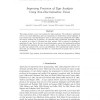Free Online Productivity Tools
i2Speak
i2Symbol
i2OCR
iTex2Img
iWeb2Print
iWeb2Shot
i2Type
iPdf2Split
iPdf2Merge
i2Bopomofo
i2Arabic
i2Style
i2Image
i2PDF
iLatex2Rtf
Sci2ools
CORR
2006
Springer
2006
Springer
Improving Precision of Type Analysis Using Non-Discriminative Union
This paper presents a new type analysis for logic programs. The analysis is performed with a priori type definitions; and type expressions are formed from a fixed alphabet of type constructors. Non-discriminative union is used to join type information from different sources without loss of precision. An operation that is performed repeatedly during an analysis is to detect if a fixpoint has been reached. This is reduced to checking the emptiness of types. Due to the use of non-discriminative union, the fundamental problem of checking the emptiness of types is more complex in the proposed type analysis than in other type analyses with a priori type definitions. The experimental results, however, show that use of tabling reduces the effect to a small fraction of analysis time on a set of benchmarks.
Related Content
| Added | 11 Dec 2010 |
| Updated | 11 Dec 2010 |
| Type | Journal |
| Year | 2006 |
| Where | CORR |
| Authors | Lunjin Lu |
Comments (0)

